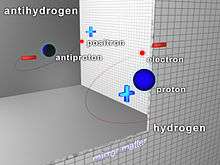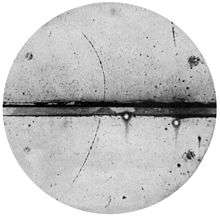Antihydrogen

| Antimatter |
|---|
 |
|
Bodies |
Antihydrogen is the antimatter counterpart of hydrogen. Whereas the common hydrogen atom is composed of an electron and proton, the antihydrogen atom is made up of a positron and antiproton. Antihydrogen has been produced artificially in particle accelerators, albeit at energies too high for detailed study. CERN experiments created low energy antimatter and trapped atoms for precision studies. Scientists hope studying antihydrogen may shed light on the baryon asymmetry problem or why there is more matter than antimatter in the universe.[1]
The standard symbol for antihydrogen is
H
.
Experimental history
Accelerators detected hot antihydrogen in the 1990s. ATHENA studied cold
H
in 2002. It was first trapped by the Antihydrogen Laser Physics Apparatus (ALPHA) team at CERN[2][3] in 2010, who then measured the structure and other important properties.[4] ALPHA, AEGIS, and GBAR plan to further cool and study
H
atoms.
Characteristics
The CPT theorem of particle physics predicts antihydrogen atoms have many of the characteristics regular hydrogen has; i.e. the same mass, magnetic moment, and atomic state transition frequencies (see atomic spectroscopy).[5] For example, excited antihydrogen atoms are expected to glow the same color as regular hydrogen. Antihydrogen atoms should be attracted to other matter or antimatter gravitationally with a force of the same magnitude that ordinary hydrogen atoms experience.[6] This would not be true if antimatter has negative gravitational mass, which is considered highly unlikely, though not yet empirically disproven (see gravitational interaction of antimatter).[7]
When antihydrogen comes into contact with ordinary matter, its constituents quickly annihilate. The positron annihilates with an electron to gamma rays. The antiproton, on the other hand, is made up of antiquarks that combine with quarks in either neutrons or protons, resulting in high-energy pions, that quickly decay into muons, neutrinos, positrons, and electrons. If antihydrogen atoms were suspended in a perfect vacuum, they should survive indefinitely.
As an antielement, it is expected to have exactly the same properties as hydrogen.[8] For example, antihydrogen would be a gas under standard conditions and combine with antioxygen to form antiwater,
H
2
O
.
Production
In 1995, the first antihydrogen was produced by a team led by Walter Oelert at CERN.[9] In the LEAR, antiprotons from an accelerator were shot at xenon clusters,[10] producing electron-positron pairs. Antiprotons can capture positrons with probability about 10−19, so this method is not suited for substantial production, as calculated.[11][12][13] Fermilab measured a somewhat different cross section,[14] in agreement with QED predictions.[15] Both resulted in highly energetic, or hot, anti-atoms, unsuitable for detailed study.
Subsequently CERN built the Antiproton Decelerator (AD) to support efforts towards low-energy antihydrogen, for tests of fundamental symmetries. The AD will supply several CERN groups. CERN expects their facilities will be capable of producing 10 million antiprotons per minute.[16]
Low-energy antihydrogen
Experiments by the ATRAP and ATHENA collaborations at CERN, brought together positrons and antiprotons in Penning traps, resulting in synthesis at a typical rate of 100 antihydrogen atoms per second. Antihydrogen was first produced by ATHENA in 2002,[17] and then by ATRAP[18] and by 2004, millions of antihydrogen atoms were made. The atoms synthesized had a relatively high temperature (a few thousand kelvin), and would hit the walls of the experimental apparatus as a consequence and annihilate. Most precision tests require long observation times.
ALPHA, a successor of the ATHENA collaboration, was formed to stably trap antihydrogen.[19] While electrically neutral, its spin magnetic moments interact with an inhomogeneous magnetic field; some atoms will be attracted to a magnetic minimum, created by a combination of mirror and multipole fields.[20]
In November 2010, the ALPHA collaboration announced that they had trapped 38 antihydrogen atoms for a sixth of a second,[21] the first confinement of neutral antimatter. In June 2011, they trapped 309 antihydrogen atoms, up to 3 simultaneously, for up to 1,000 seconds.[22][23] They then studied its hyperfine structure, gravity effects, and charge. ALPHA will continue measurements along with experiments ATRAP, AEGIS and GBAR.
Larger antimatter atoms such as antideuterium (
D
), antitritium (
T
), and antihelium (
He
) are much more difficult to produce. Antideuterium,[24][25] antihelium-3 (3
He
)[26][27] and antihelium-4 (4
He
) nuclei[28] have been produced with such very high velocities that synthesis of their corresponding atoms poses several technical hurdles.
See also
References
- ↑ BBC News – Antimatter atoms are corralled even longer. Bbc.co.uk. Retrieved on 2011-06-08.
- ↑ Eugenie Samuel Reich, "Antimatter held for questioning", Nature News 2010-11-17, accessed 2010-11-20
- ↑ eiroforum.org – CERN: Antimatter in the trap Archived February 3, 2014, at the Wayback Machine., December 2011, accessed 2012-06-08
- ↑ Internal Structure of Antihydrogen probed for the first time Archived April 23, 2012, at the Wayback Machine.. March 7, 2012.
- ↑ The Coolest Antiprotons at Physical Review, Focus , paragraph 2
- ↑ Antimatter held for questioning at naturenews , paragraph 7
- ↑ "Antihydrogen trapped for a thousand seconds". May 2, 2011.
- ↑ BBC News – Antihydrogen undergoes its first-ever measurement
- ↑ Freedman, David H. "Antiatoms: Here Today . . .". Discover Magazine.
- ↑ Baur, G.; Boero, G.; Brauksiepe, A.; Buzzo, A.; Eyrich, W.; Geyer, R.; Grzonka, D.; Hauffe, J.; Kilian, K.; LoVetere, M.; Macri, M.; Moosburger, M.; Nellen, R.; Oelert, W.; Passaggio, S.; Pozzo, A.; Röhrich, K.; Sachs, K.; Schepers, G.; Sefzick, T.; Simon, R.S.; Stratmann, R.; Stinzing, F.; Wolke, M. (1996). "Production of Antihydrogen". Physics Letters B. 368 (3): 251ff. Bibcode:1996PhLB..368..251B. doi:10.1016/0370-2693(96)00005-6.
- ↑ C.A.Bertulani and G. Baur, Pair production with atomic shell capture in relativistic heavy ion collisions, Braz. J. Phys. 18 (1988) 559.
- ↑ C.A. Bertulani and G. Baur, Electromagnetic processes in relativistic heavy ion collisions, Phys. Reports 163 (1988) 299.
- ↑ Aste, Andreas; Hencken, Kai; Trautmann, Dirk; Baur, G. (1993). "Electromagnetic Pair Production with Capture". Physical Review A. 50 (5): 3980ff. Bibcode:1994PhRvA..50.3980A. doi:10.1103/PhysRevA.50.3980. PMID 9911369.
- ↑ Blanford, G.; Christian, D.C.; Gollwitzer, K.; Mandelkern, M.; Munger, C.T.; Schultz, J.; Zioulas, G. (December 1997). "Observation of Atomic Antihydrogen". Physical Review Letters. Fermi National Accelerator Laboratory. 80 (14): 3037. Bibcode:1997APS..APR.C1009C. doi:10.1103/PhysRevLett.80.3037.
FERMILAB-Pub-97/398-E E862 ... p and H experiments
- ↑ C.A. Bertulani and G. Baur, Theoretical calculation of antihydrogen production and accuracy of the equivalent photon approximation, Phys. Rev. D58: 034005, 1998.
- ↑ N. Madsen (2010). "Cold antihydrogen: a new frontier in fundamental physics". Philosophical Transactions of the Royal Society A. 368 (1924): 3671–82. Bibcode:2010RSPTA.368.3671M. doi:10.1098/rsta.2010.0026. PMID 20603376.
- ↑ M. Amoretti; et al. (2002). "Production and detection of cold antihydrogen atoms". Nature. 419 (6906): 456–9. Bibcode:2002Natur.419..456A. doi:10.1038/nature01096. PMID 12368849.
- ↑ Gabrielse, G.; et al. (2002). "Driven Production of Cold Antihydrogen and the First Measured Distribution of Antihydrogen States". Phys. Rev. Lett. 89 (23): 233401. Bibcode:2002PhRvL..89w3401G. doi:10.1103/PhysRevLett.89.233401.
- ↑ N. Madsen (2010). "Cold antihydrogen: a new frontier in fundamental physics". Philosophical Transactions of the Royal Society A. 368 (1924): 3671–82. Bibcode:2010RSPTA.368.3671M. doi:10.1098/rsta.2010.0026. PMID 20603376.
- ↑ D. E. Pritchard; Heinz, T.; Shen, Y. (1983). "Cooling neutral atoms in a magnetic trap for precision spectroscopy". Physical Review Letters. 51 (21): 1983. Bibcode:1983PhRvL..51.1983T. doi:10.1103/PhysRevLett.51.1983.
- ↑ Andresen, G. B. (ALPHA Collaboration); et al. (2010). "Trapped antihydrogen". Nature. 468 (7324): 673–676. Bibcode:2010Natur.468..673A. doi:10.1038/nature09610. PMID 21085118.
- ↑ Andresen, G. B. (ALPHA Collaboration); et al. (2011). "Confinement of antihydrogen for 1,000 seconds". Nature Physics. 7 (7): 558. arXiv:1104.4982
 . Bibcode:2011NatPh...7..558A. doi:10.1038/nphys2025.
. Bibcode:2011NatPh...7..558A. doi:10.1038/nphys2025. - ↑ Andresen. G. B. (ALPHA Collaboration); et al. (2011). "Confinement of antihydrogen for 1,000 seconds". arXiv:1104.4982
 [physics.atom-ph].
[physics.atom-ph]. - ↑ Massam, T; Muller, Th.; Righini, B.; Schneegans, M.; Zichichi, A. (1965). "Experimental observation of antideuteron production". Il Nuovo Cimento. 39: 10–14. Bibcode:1965NCimS..39...10M. doi:10.1007/BF02814251.
- ↑ Dorfan, D. E; Eades, J.; Lederman, L. M.; Lee, W.; Ting, C. C. (June 1965). "Observation of Antideuterons". Phys. Rev. Lett. 14 (24): 1003–1006. Bibcode:1965PhRvL..14.1003D. doi:10.1103/PhysRevLett.14.1003.
- ↑ Y.M. Antipov; et al. (1974). "Observation of antihelium3 (in Russian)". Yadernaya Fizika. 12: 311.
- ↑ R. Arsenescu; et al. (2003). "Antihelium-3 production in lead-lead collisions at 158 A GeV/c". New Journal of Physics. 5: 1. Bibcode:2003NJPh....5....1A. doi:10.1088/1367-2630/5/1/301.
- ↑ H. Agakishiev; et al. (2011). "Observation of the antimatter helium-4 nucleus". Nature. 473 (7347): 353–6. arXiv:1103.3312
 . Bibcode:2011Natur.473..353T. doi:10.1038/nature10079. PMID 21516103.
. Bibcode:2011Natur.473..353T. doi:10.1038/nature10079. PMID 21516103.
External links
- Merrifield, Michael; Copeland, Ed. "
H
Antihydrogen". Sixty Symbols. Brady Haran for the University of Nottingham.